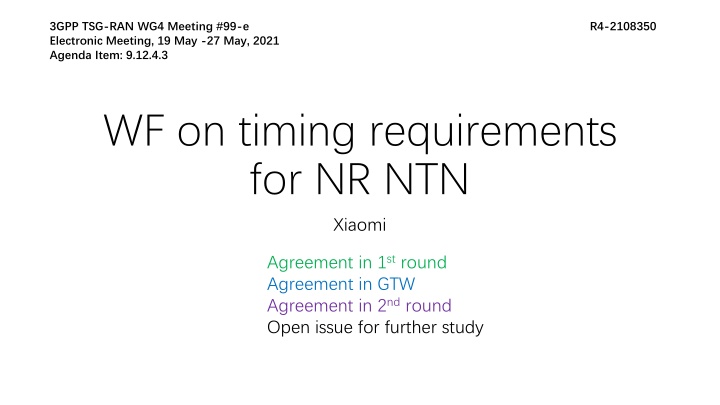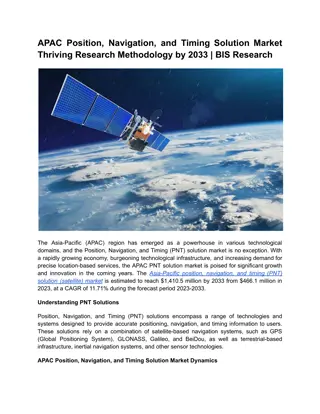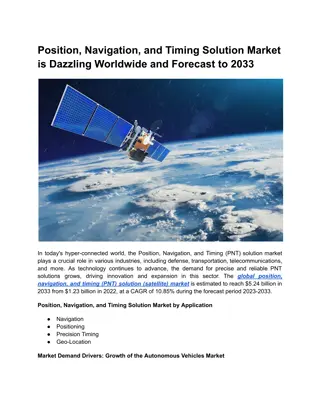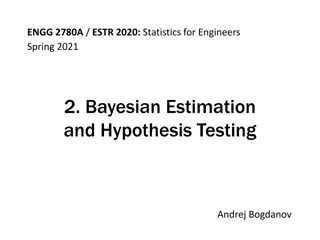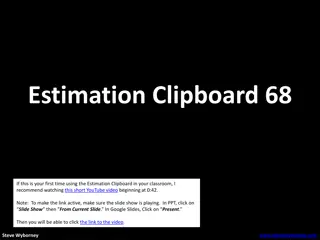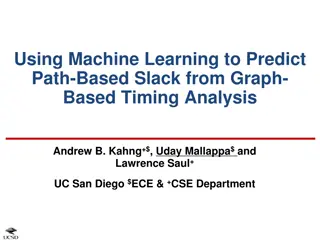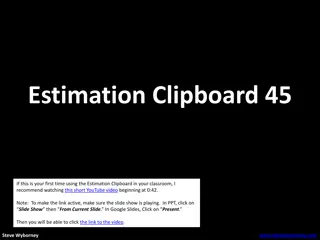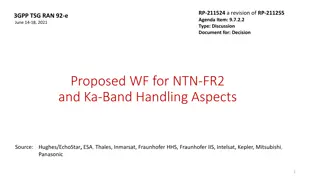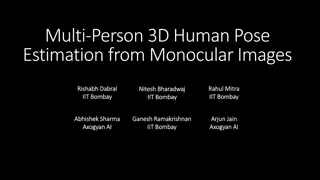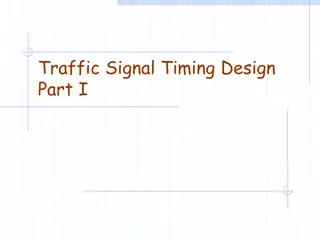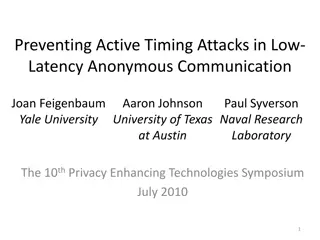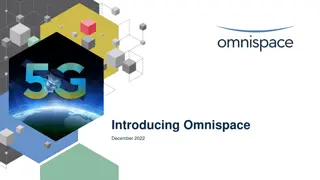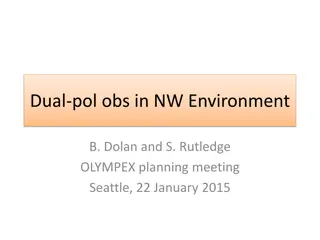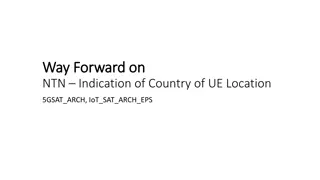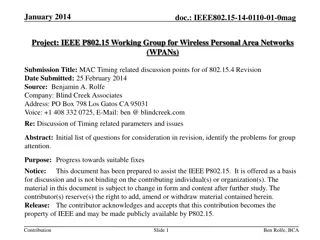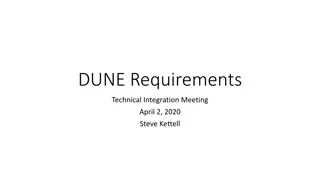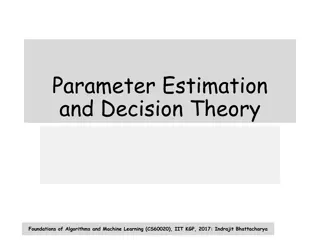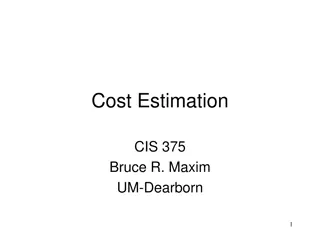Timing Requirements for NR NTN - Discussion on UE-Specific TA Estimation
Discussing the accuracy and update rate requirements for UE-specific TA estimation in the context of NR NTN, including considerations on UE behavior and initial transmit timing requirements.
Download Presentation

Please find below an Image/Link to download the presentation.
The content on the website is provided AS IS for your information and personal use only. It may not be sold, licensed, or shared on other websites without obtaining consent from the author.If you encounter any issues during the download, it is possible that the publisher has removed the file from their server.
You are allowed to download the files provided on this website for personal or commercial use, subject to the condition that they are used lawfully. All files are the property of their respective owners.
The content on the website is provided AS IS for your information and personal use only. It may not be sold, licensed, or shared on other websites without obtaining consent from the author.
E N D
Presentation Transcript
3GPP TSG-RAN WG4 Meeting #99-e Electronic Meeting, 19 May -27 May, 2021 Agenda Item: 9.12.4.3 R4-2108350 WF on timing requirements for NR NTN Xiaomi Agreement in 1stround Agreement in GTW Agreement in 2ndround Open issue for further study
WF on UE specific TA estimation error (1/2) Whether to define a separate accuracy requirement for UE specific TA estimation Option 1: Yes (Intel, NEC, THALES, Ericsson) Option 2: No(QC, CATT, Xiaomi, CMCC, LGE, CATT, Apple, Huawei, MTK, Ericsson, ZTE) FFS the UE specific TA estimation accuracy Whether to define the update rate for UE specific TA estimation Option 1: Yes (Intel, CMCC, Ericsson, LGE) Option 2: No (CATT, Xiaomi, Apple, Huawei, MTK, Qualcomm, ZTE, THALES) Option 3: Under discussion in RAN1 (LGE) Whether to define UE behaviour related to UE specific TA estimation Option 1: Defer discussion for specifying UE behaviour related to UE specific TA estimation, and wait RAN1 conclusion (CATT, CMCC) Option 2: Specify UE behaviour related to the combination of UE specific TA estimation (NTA,UE specific) and self-estimated TA common (NTA,common) (THALES, Ericsson, Intel) Option 3: No need to define UE behavior for UE specific TA estimation as a requirement, as long as UE can meet the timing requirement, i.e., Te/Tq/Tp (Apple, Xiaomi, Huawei, Qualcomm, ZTE) Wait RAN1/RAN2 conclusions on UE specific TA pre-compensation reporting to determine whether we need to define separate UE specific TA estimation requirement or not
WF on UE specific TA estimation error (2/2) Whether to define a separate accuracy requirement for self-estimated TA common (NTA,common) Option 1: Yes (THALES, Ericsson) Option 2: No (Apple, Xiaomi, Huawei, Qualcomm, CATT, CMCC, LGE) Whether to define a separate accuracy requirement for the combination of NTA,UE specific+NTA,common Option 1: Yes (THALES, Ericsson) Option 2: No (Apple, Xiaomi, Huawei, Qualcomm, CATT, LGE) It is up to RAN1/RAN2 decision on whether UE should use the referenceTimeInfo-R16 and GNSS- provided time reference to calculate TA at the UE
WF on UE initial transmit timing requirements (1/2) The composites should be considered for initial transmit timing requirement in NTN (Te_NTN) Option 1: (QC, Xiaomi, Huawei, LGE, ZTE, NEC, CMCC) UE position estimation error Serving-satellite position estimation error The current UE transmit timing error requirement Option 1a: (LGE, MTK, Huawei, ZTE) GNSS inaccuracy The current UE transmit timing error requirement Option 2: (Apple) legacy Te UE specific TA estimation error (without ephemeris uncertainty) Option 3: (THALES, Ericsson) The accuracy of UE specific TA estimation (N_(TA,UE-specific)) and self-estimated TA common (N_(TA,common)) is counted into the UE transmit timing error requirement.
WF on UE initial transmit timing requirements (2/2) GNSS position error assumption for Te_NTN Option 1: (QC, LGE) at least 50m, and further relax up to 100m Option 2: (Xiaomi, CATT, THALES, Apple) 50m Option 3: (CMCC, CATT) 50m as the worst case and 20m as the typical case Option 4: (MTK, Xiaomi, THALES, NEC, Intel) For UL SCS of 15/30 kHz: <= 50 m For UL SCS of 60/120 kHz: <= 30 m Option 5: (Apple, LGE, Nokia) The worst case: 100m Whether to define general GNSS positioning accuracy requirements? Option 1: (Huawei, Ericsson, Nokia, THALES) Yes, it is suggested to define general GNSS positioning accuracy requirements which can be referred for deriving other RRM requirements. Option 2: No (Apple, Xiaomi, QC, CATT, CMCC, Intel) FFS FFS the reference timing for UE initial transmission
WF on gradual timing adjustment requirements (1/2) RAN4 to introduce new gradual timing adjustment requirements for NTN network. FFS the minimum aggregate adjustment rate: Tp_NTN FFS the maximum aggregate adjustment rate: Tq_NTN Whether define different gradual timing adjustment requirements for different NTN topologies e.g. GEO, MEO, LEO Option 1: Yes (CATT, Xiaomi, Ericsson) Option 2: FFS (QC, CMCC, Apple, Huawei, ZTE, THALES, NEC, Intel) The assumptions will be used to define gradual timing adjustment requirements for NTN network Option 1: UE performs timing adjustment for downlink reception timing drifting and UE specific TA change separately. (Huawei, MTK, Ericsson, Xiaomi) Option 2: UE performs timing adjustment with combining downlink reception timing drifting and UE specific TA change as one adjustment. (Huawei, Apple, QC, THALES, CMCC, Intel)
WF on gradual timing adjustment requirements (2/2) Whether the maximum delay variation should be considered in the gradual timing adjustment requirement in NTN? Option 1: Yes (Xiaomi, CMCC, Ericsson, Apple, Huawei, QC, Ericsson) Option 2: FFS (CATT, MTK, THALES, NEC) FFS the direction of timing adjustment for NTN UE pre-compensation
WF on TA adjustment accuracy requirement Not define TA adjustment accuracy requirement in RRC_IDLE mode. Whether the UE position and satellite position estimation error should be accounted for TA adjustment accuracy requirement? Option 1: Yes (Xiaomi, LGE, Nokia) Option 2: Depends on RAN1 design (QC, CMCC, LGE, CATT, CMCC) Option 3: No (Apple, Huawei, NEC) TA adjustment accuracy requirement in RRC_CONNECTED mode Option 1: (NEC, Huawei, Ericsson, Apple, MTK, NEC) Reuse the existing timing advance adjustment accuracy requirements defined in TS 38.133. Option 1a: (NEC) RAN4 to reuse the existing TA adjustment accuracy requirement defined in TS 38.133 with considering of UL timing quantization accuracy. Option 2: (Xiaomi, LGE) RAN4 is to define a relaxed TA adjustment accuracy requirement for NR NTN Option 2a: (QC) Request RAN1 whether and how to reflect a propagation delay change, i.e. open loop TA update, from a slot when UE received timing advance command to a slot when the indicated timing advance shall be applied to uplink transmission. If defined, depending on RAN1 design NTN UE timing advance adjustment accuracy requirements may have to be relaxed to account for UE position and satellite position estimation error. And if it is decided to relax the requirement, the accuracy requirement relaxation shall be the same as that for initial timing error requirement. UE behaviour before applying timing advance adjustment for its uplink transmission FFS the TA adjustment accuracy impact due to the open loop and closed loop TA adjustment.
